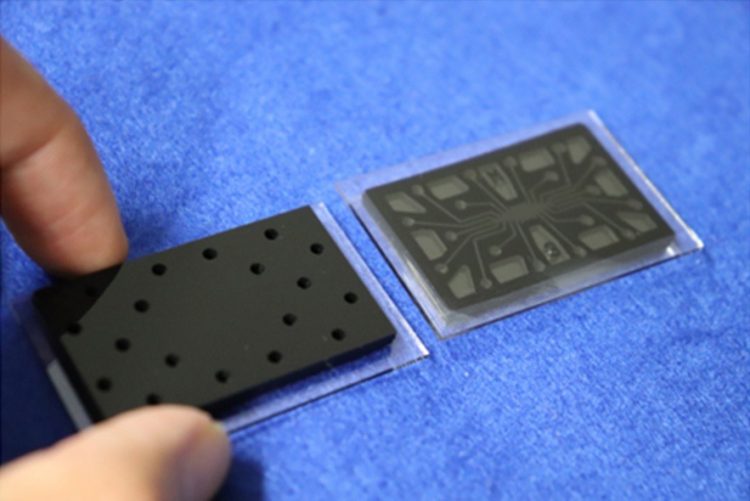New technology can detect anti-virus antibody in 20 minutes

The microfluidic device to which ∼20 μL of samples containing 2 μL of serum will be applied. (Nishiyama K. et al., Sensors and Actuators B: Chemical. April 21, 2020) Usage Restrictions: This image is copyrighted and can be used for reporting this research work without obtaining a permission if credited as instructed.
Avian influenza is a poultry disease caused by influenza A virus infection. Rapid initial response for a suspected infection and continuous surveillance are essential to mitigate the damage from highly pathogenic, transmittable pathogens such as avian influenza viruses.
Generally, the polymerase chain reaction (PCR) method is used to detect the viral genome, but its complicated procedure requires a considerable amount of time. Another method involves detecting antibodies produced in the body in reaction to virus infection.
However, widely used antibody detection methods can be inaccurate because the antibodies' existence is generally determined by eyesight.
The group, including Keine Nishiyama, a doctoral student at Hokkaido University's Graduate School of Chemical Science and Engineering, and Professor Manabu Tokeshi of the university's Faculty of Engineering, conducted this study to develop a new method and analyzer capable of rapid, facile and selective detection of antibodies.
The method is based on conventional fluorescence polarization immunoassay (FPIA) but applies a different measurement mechanism to make the analyzer much smaller and portable. The analyzer weighs only 5.5 kilograms.
The combined use of liquid crystal molecules, an image sensor and the microfluidic device makes it possible to simultaneously examine multiple samples and reduces the volume of each sample required. Liquid crystal molecules are capable of controlling the polarization direction of fluorescent light, while the microfluidic device has a number of microchannels as a measurement vessel.
The group also developed a reagent to detect anti-H5 avian influenza virus antibody, a fluorescein-labeled protein that binds only with the antibody. The reagent was made by reproducing hemagglutinin (HA) protein fragments, which are expressed on the surface of H5 avian influenza virus, through gene recombination and by labeling fluorescent molecules to the fragments.
To make the measurement, serum collected from birds was mixed with the reagent and left for 15 minutes. The mixture was injected into the microfluidic device and measured with the portable fluorescence polarization analyzer. Molecular movements of the reagent bound with the antibody will be smaller in the liquid, producing a different degree of polarization from the reagent not bound with the antibody. The system can detect anti-H5 avian influenza virus antibody with only 2 microliters of serum sample and within 20 minutes.
“Our analyzer could be used to conduct other bio tests if suitable reagents are developed,” says Tokeshi. The group has already successfully detected mycotoxin and drug constituents. “By reproducing fragments of spike proteins expressed in the novel coronavirus, and using them as the reagent, the analyzer should be able to detect anti-coronavirus antibodies.”
Media Contact
All latest news from the category: Medical Engineering
The development of medical equipment, products and technical procedures is characterized by high research and development costs in a variety of fields related to the study of human medicine.
innovations-report provides informative and stimulating reports and articles on topics ranging from imaging processes, cell and tissue techniques, optical techniques, implants, orthopedic aids, clinical and medical office equipment, dialysis systems and x-ray/radiation monitoring devices to endoscopy, ultrasound, surgical techniques, and dental materials.
Newest articles

Scientists transform blood into regenerative materials
… paving the way for personalized, blood-based, 3D-printed implants. Scientists have created a new ‘biocooperative’ material based on blood, which has shown to successfully repair bones, paving the way for…

A new experimental infection model in flies
…offers a fast and cost-effective way to test drugs. Researchers at the Germans Trias i Pujol Research Institute and Hospital have reinforced their leading role in infectious disease research by…

Material developed with novel stretching properties
KIT researchers produce metamaterial with different extension and compression properties than conventional materials. With this material, the working group headed by Professor Martin Wegener at KIT’s Institute of Applied Physics…



